If there’s one word that seems to have fallen out of favour recently it’s “disrupt”. This is so true that the word “disrupt” has become one of the words in Time magazine’s somewhat disastrous 20 words to ban poll of 2014.
What is Disruptive Innovation?

Author/Copyright holder: Innovation. Copyright terms and licence: All rights reserved. Img
The term disruptive innovation refers to a new product or service that is so incredibly powerful that it changes a market completely or creates a brand new market. For example, the iPhone, could be considered a disruptive technology. Prior to that phone there were no real internet compatible cellular phones; now it’s rare, even in the developing world, to see a phone that isn’t internet compatible. The iPhone disrupted the traditional cellular telephony market and replaced it with a new market; the smartphone market.
There are two main types of disruption:
The New Market Disruption

Author/Copyright holder: Unknown. Copyright terms and licence:Unknown.
These are the disruptions that most of us dream of being involved with. They are the transition from film to digital photography, the move from Nokia to Apple in the cell phone market place and so on. They do not initially create any form of market competition; they simply create a new market and in many cases it is easy for customers to transition from one market to the next. Of course, any new market will eventually end up competitive but in the first instance; there is always a good chance for the market leader to establish competitive strength or even market dominance in the interim.
The Low End Disruption

Author/Copyright holder: Vicky Woodward. Copyright terms and licence: CC BY 2.0
These are more subtle but vital market disruptions. They are not built on quality or innovation that leads to brand new products; they are built on the kind of innovation that enables a reduction in cost – and one significant enough to enable the capture of a large market share in an established market very quickly.
Countries do this to each other; China’s manufacturing economy simply disrupted much of America’s low end manufacturing. Wage costs enabled instant transitions of supplier choices. Retail stores have done it too; the emergence of the “stack it high, sell it cheap” model led to the emergency of the supermarket and then the mega-markets of today.
The Death of Disruptive Innovation in Design?
It seems highly unlikely that disruptive innovation is coming to a close. While the buzzword of the moment “disruptive” may be replaced by another less-jarring term; the concept is here to stay.
This is why many people choose design as a career path; the chance to invent the iPhone killer or the sub $1,000 car (which has already happened). The urge to innovate won’t disappear because Time magazine is annoyed with a word.
If you’d like to learn more about disruptive innovation and how it can impact a variety of markets in a variety of ways; then you might want to read Disruptive Innovation here. It is completely free to read and it was written by Clayton M Christensen a professor at Harvard Business School. He is the world’s leading authority on disruptive innovation.
Header Image: Author/Copyright holder: Haydn Shaughnessy. Copyright terms and licence: All rights reserved. Img











